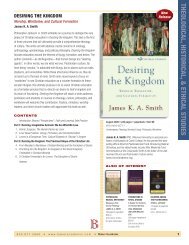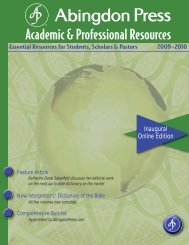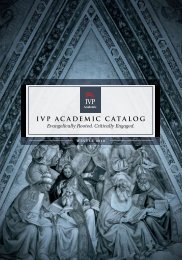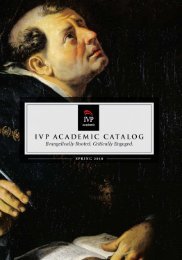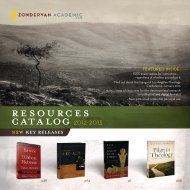koinonia
new releases
new releases
Create successful ePaper yourself
Turn your PDF publications into a flip-book with our unique Google optimized e-Paper software.
34<br />
Nero being crowned by Agrippina.<br />
Part 1:<br />
Hebrews: The Book of Better Things<br />
0310267382_LettersChurch_int_CS4_1.indd 34<br />
his Circus, mixing with the crowd in the habit of a charioteer, or mounted<br />
on his car. Hence, in spite of a guilt which had earned the most<br />
exemplary punishment, there arose a sentiment of pity, due to the<br />
impression that they [the Chris tians] were being sacrificed not<br />
for the welfare of the state but to the ferocity of a single man [i.e.,<br />
Nero]. (Tacitus, Ann. 15.54)<br />
Left: Interior of Colosseum Right: The Colosseum of Rome, built in 75-80 CE under the Flavian Emperors Vespasian and Titus.<br />
6/14/11 10:58 AM<br />
0310267382_LettersChurch_int_CS4_3.indd 313<br />
Left: Clement of Alexandria (ca. AD 150 – 222). Right: Augustine, a Latin father of the early<br />
church lived in North Africa in the late 4th to early 5th centuries.<br />
ejn wÇ/ kai© toiÇß ejn fulakh©/ pneuvmasin poreuqei©ß ejkhvruxen (1 Peter 3:19)<br />
1. Christ Preaches through Noah<br />
In his spiritual realm of existence, Christ went and preached through Noah to<br />
those who are now spirits in the prison of hell. He did this preaching through<br />
Noah’s mouth when they formerly disobeyed, when the patience of God was<br />
waiting in the days of Noah while the ark was being built.<br />
2. Christ Proclaims Victory by His Resurrection and Ascension<br />
In [this realm of the Spirit], Christ ascended [“went”] and, in so doing, proclaimed<br />
final defeat to the spirits in prison who were the fallen angels and<br />
who in times past disobeyed when the patience of God waited in the days of<br />
Noah while the ark was being built.<br />
3. Christ Descends into Hell (Apostles’ Creed)<br />
Christ’s spirit descended [into hell] on Easter Saturday and preached grace to<br />
[and released] the imprisoned souls who in times past disobeyed when the<br />
patience of God waited in the days of Noah while the ark was being built.<br />
Chapter 10:<br />
“Christ Has Left You an Example”<br />
313<br />
Rome<br />
0 300 km.<br />
0 300 miles<br />
6/14/11 8:31 AM<br />
0310267382_LettersChurch_int_CS4_3.indd 315<br />
Athens<br />
Troas<br />
Ephesus<br />
Black Sea<br />
The letter of 1 Peter, and probably also 2 Peter, was written to Chris tians living in the five Roman provinces in Asia Minor: Pontus,<br />
Galatia, Cappadocia, Asia, and Bithynia.<br />
Mt. Ararat<br />
the sons of God saw that the daughters of humans were beautiful, and they married<br />
any of them they chose. ...<br />
The Nephilim were on the earth in those days — and also afterward — Ancient coins recovered from Asia Minor<br />
when the sons of God went to the daughters of humans and had children by attest to the popularity of Noah<br />
them. . . .<br />
The Lord saw how great the wickedness of the human race had become on the earth,<br />
and that every inclination of the thoughts of the human heart was only evil all the time.”<br />
(Gen. 6:2, 4 – 5)<br />
Chapter 10:<br />
“Christ Has Left You an Example”<br />
315<br />
6/14/11 8:32 AM<br />
158<br />
Left: A vineyard near the tell, or mound, of Lachish. Right: A watchtower in the hills of Samaria.<br />
Part 1:<br />
The Gospel of John<br />
The Roman Empire.<br />
Atlantic<br />
Ocean<br />
Tagus R.<br />
SPAIN<br />
0 300 km.<br />
0 300 miles<br />
BRITAIN<br />
Loire R.<br />
GAUL<br />
Lyon<br />
GERMANY<br />
Po R.<br />
CORSICA<br />
Rome<br />
SARDINIA<br />
SICILY<br />
Sea<br />
Danube R.<br />
MOESIA<br />
Philippi<br />
Troas<br />
MYSIA<br />
ACHAIA<br />
Corinth<br />
Athens Ephesus<br />
Lystra<br />
Antioch<br />
CRETE<br />
CYPRUS<br />
Cyrene<br />
Alexandria<br />
Jerusalem<br />
CYRENE Memphis<br />
EGYPT<br />
There are also those who heard from him [Polycarp] that John, the disciple of the Lord,<br />
going to bathe at Ephesus, and perceiving Cerinthus within, rushed out of the bath-house<br />
without bathing, exclaiming, “Let us fly, lest even the bath-house fall down, because Cerinthus,<br />
the enemy of the truth, is within” (Against Heresies 3.3.4).<br />
18. See Burge’s documentation in Letters of John, 21 – 22.<br />
19. The following primary texts are collected by Kruse, The Letters of John, 20 – 26. I follow his translations.<br />
Chapter 25:<br />
Introduction to the Epistles of John<br />
0 310 267374_01_WritingsofJohn_4thPgs_CS4.indd 235 9/23/10 4:59 PM<br />
0 310 267374_01_WritingsofJohn_4thPgs_CS4.indd 158 9/23/10 4:58 PM<br />
0 310 267374_02_WritingsofJohn_4thPgs_CS4.indd 394 9/23/10 4:45 PM<br />
Vistula R.<br />
MACEDONIA<br />
D A C<br />
I A<br />
I A<br />
Black Sea<br />
PONTUS<br />
CAPPADOCIA<br />
CILICIA<br />
Edessa<br />
ARMENIA<br />
Babylon<br />
PARTHIA<br />
235<br />
394<br />
Part 3:<br />
Revelation<br />
A model of a papyrus document sealed with four bulae (clay seals).<br />
v. 8: “Holy, holy, holy” (see Isa. 6:3) vv. 1 – 6: alone worthy — (implied) holy<br />
v. 8: “was, and is, and is to come” = eternal v. 13: “for ever and ever” = eternal<br />
v. 9: “glory, honor and thanks” v. 12: “power and wealth and wisdom and<br />
strength and honor and glory and praise”<br />
v. 11: “glory and honor and power” v. 13: “honor and glory and power”<br />
v. 11: worthy vv. 9, 12: “worthy”<br />
v. 11: Creator vv. 9 – 10: Redeemer<br />
vv. 2 – 3: sits on the throne<br />
v. 13: sits on the throne<br />
11. The Spirit is not left out of this picture of worship; the reference in Revelation 5:6 – 7 to “seven horns and<br />
seven eyes” seems to allude to the third member of the Trinity.<br />
12. There are some sixteen heavenly hymns to God and Christ in Revelation; see Aune’s analysis, Revelation<br />
1 – 5, 314 – 17.<br />
New Testament<br />
Letters to the Church<br />
A Survey of Hebrews and the General Epistles<br />
Karen H. Jobes<br />
usd $44.99<br />
Hardcover • 496 pages<br />
ISBN 9780310267386<br />
Respected New Testament scholar<br />
Karen Jobes explores Hebrews and the<br />
general epistles, addressing issues of<br />
historical relevance and showing how<br />
these ancient books connect with<br />
Christian faith and practice today. An<br />
inviting survey, rich in information and<br />
graphics, Letters to the Church stands<br />
to become the standard textbook for<br />
the study of these epistles.<br />
karen h. jobes (PhD, Westminster<br />
Theological Seminary) is the Gerald F.<br />
Hawthorne Professor of New Testament<br />
Greek and Exegesis at Wheaton College.<br />
The Writings of John<br />
A Survey of the Gospel, Epistles, and Apocalypse<br />
c. marvin pate<br />
usd $44.99<br />
Hardcover • 560 pages<br />
ISBN 9780310267379<br />
C. Marvin Pate addresses John’s writings<br />
according to their logical divisions:<br />
the Gospel of John, the Johannine<br />
Epistles, and Revelation. Each section<br />
includes a thorough introduction to<br />
relevant interpretive issues, including<br />
historical background, cultural setting,<br />
and theological context. He examines<br />
issues like authorship, audience, and<br />
theological perspective.<br />
The Gospel of John, 1–3 John,<br />
and Revelation receive paragraph-byparagraph<br />
commentary. The Writings of<br />
John includes thorough discussion, a winning textbook design,<br />
and a full-color interior.<br />
biblical studies<br />
DIGITAL<br />
FORMATS<br />
book<br />
C. MARVIN PATE (PhD, Marquette University) is chair and<br />
Elma Cobb Professor of Christian Theology at Ouachita<br />
Baptist University.<br />
• Chapter quizzes<br />
• Sample syllabus<br />
• Image/map library<br />
• Map quizzes<br />
• Quizzes*<br />
• Flashcards*<br />
TextbookPlus.Zondervan.com<br />
DIGITAL<br />
FORMATS<br />
book<br />
© Anne Marie Clarke<br />
In light of this persecution, the book of Hebrews was<br />
addressed to Chris tians who “have not yet resisted to the point<br />
of shedding your blood” (12:4, emphasis added). If addressed to<br />
Chris tians living in Rome, this statement would sit best before<br />
Nero began to kill Chris tians. With the storm clouds of Nero’s<br />
hostility to Chris tians on the horizon, some may have attempted<br />
to escape persecution by withdrawing from their Chris tian<br />
commitment. Such a scenario would motivate the warnings in<br />
Hebrews against apostasy (6:4 – 8; 10:26 – 39) and the exhortations<br />
to continue meeting together despite the risk (10:19 – 25).<br />
A further consideration in regard to the date Hebrews was<br />
written is the destruction of the Jerusalem temple in AD 70. The<br />
author of Hebrews speaks of the sacrificial rituals in the present<br />
tense, and some infer that the temple must have been in operation at that time. Certainly<br />
the author’s argument that Jesus is the unique and final sacrifice after which no further<br />
sacrifices are necessary would have been strongly supported by pointing out the fact that<br />
the Jerusalem temple had been destroyed, were that the case. However, the grammatical<br />
present tense itself is not sufficient grounds for arguing a date of writing, for the present<br />
tense in Greek has other relationships to time.<br />
To complicate matters, the author of Hebrews does not actually refer to the “temple”<br />
at all. Whenever the author refers to the sacred place where sacrifice was made under the<br />
old covenant, he uses the word tabernacle, a portable tent used for worship by ancient Israel<br />
(8:2, 5; 9:1, 2, 8, 11, 21; 13:10). In fact, the Greek words for “temple” (hieron and naos) don’t<br />
occur at all in Hebrews. This point has been used to argue that Hebrews was written after the<br />
Todd Bolen/www.BiblePlaces.com<br />
© Alexey Arkhipov/www.BigStockPhoto.com<br />
could gain salvation. Origen and Cyril of<br />
Alexandria followed Clement, and this<br />
interpretation continued to enjoy popularity<br />
in the Eastern church. Even some today<br />
who argue a postmortem opportunity for<br />
conversion interpret 1 Peter 3:18 – 22 as<br />
suggesting that possibility, often reading<br />
1 Peter 4:6 in the same light.<br />
Augustine, a Latin church father living<br />
at the turn of the fourth to fifth century<br />
in North Africa, was troubled by the idea<br />
of postmortem conversion, for Scripture<br />
clearly seems to teach that one’s eternal<br />
destiny is determined in this life. He most<br />
likely was not aware of 1 Enoch, which had<br />
disappeared from popular circulation by<br />
that time. Augustine, who could not read Greek very well and was more concerned with<br />
theological interpretation than with the syntax of the text, offered the alternate interpretation<br />
that the preincarnate Christ “went” to Noah’s generation and preached repentance<br />
through Noah to those about to perish in the great flood, but who were dead at the time<br />
Peter wrote and so were “spirits in prison.” This view would take its cue from Peter’s statement<br />
in 1:10 – 12, that it was the Spirit of Christ who revealed to the Old Testament prophets<br />
the sufferings of the Messiah and the glories that would follow.<br />
Nine Greek Words at the Heart of the Exegetical Debate<br />
Andre Thevet<br />
St. Augustine, Francesca, Piero della/National Museum of Ancient Art, Lisbon,<br />
Portugal/The Bridgeman Art Library<br />
I TA LY<br />
Adriatic Sea<br />
M e d i<br />
Aegean Sea<br />
t e r<br />
r a n<br />
of the one told in Genesis. When Jewish colonists came to Asia Minor during the Seleucid<br />
period, they noticed the name of a town that had the Greek word for “ark” in it (Apameia<br />
Kibotos, modern Dinar) and assumed it to be the place where Noah’s ark came to rest. At<br />
some point, Noah’s name became identified with the great but anonymous Apamean<br />
flood hero, and consequently Noah became a part of the indigenous<br />
culture of Asia Minor. His fame in that region is attested by coins minted<br />
during the Roman period showing him and his wife in an ark.<br />
Noah’s fame in Asia Minor allowed Peter to allude to the tradition<br />
preserved in 1 Enoch. Noah’s story in the Bible follows after the disappearance<br />
of Enoch, who “walked faithfully with God; then he was no<br />
more, because God took him away” (Gen. 5:24). Noah’s story begins with<br />
Genesis 6 and the mysterious statement that<br />
Although nothing further is said in Scripture about Enoch or the Nephilim, a large<br />
corpus of tradition developed within Judaism about them. The book of 1 Enoch was a very<br />
popular version of Jewish tradition that brought Enoch and the Nephilim together. In<br />
A S I A<br />
B I T H Y N I A<br />
e a n<br />
P O N T U S<br />
G A L AT I A<br />
S e a<br />
S Y R I A<br />
C A P PA D O C I A<br />
© 2011 Museum of Fine Arts, Boston<br />
INTRODUCTION<br />
John 15:1 – 16:4a seems to form a self-contained unit, focusing on two main themes: the<br />
vine and the branches (15:1 – 17), and the hatred of the world for Jesus and his disciples<br />
(5:18 – 16:4a).<br />
I. THE VINE AND THE BRANCHES (15:1 – 17)<br />
John 15:1 – 17 contains the majestic description of Jesus as the vine and his followers as the<br />
branches. The commentators agree that John 15:1 – 17 divides into two parts: the allegory<br />
of the vine and the branches (vv. 1 – 6), and the explanation of that allegory (vv. 7 – 17).<br />
John 15:1 – 16:4a seems to form a A. The Allegory of the Vine and the Branches (vv. 1 – 6)<br />
John 15:1 – 6 is an allegory, an extended metaphor. Unlike parables,<br />
which tend to make one basic point, an allegory makes<br />
self-contained unit, focusing on<br />
several points. Here in verses 1 – 6 Jesus’ horticultural allegory<br />
emphasizes three symbols: the vine, the gardener, and the<br />
two main themes: the vine and<br />
the branches (15:1 – 17), and the branches.<br />
hatred of the world for Jesus and 1. The Vine (v. 1a)<br />
“I am the true vine” is the last of the seven “I am” sayings<br />
his disciples (5:18 – 16:4a). in John. The background of Jesus’ usage of the vine imagery<br />
is Old Testament Israel, which is called the vineyard of God<br />
in several famous passages: Psalm 80:8 – 18; Isaiah 5:1 – 7; Jeremiah 2:21; Ezekiel 15:1 – 5;<br />
17:1 – 2; 19:10 – 14; Hosea 10:1 – 2; cf. Leviticus Rabbah 36 (133a); Matthew 20:1 – 16; Mark<br />
12:1 – 12; Luke 13:6 – 9.<br />
The striking characteristic of the above Old Testament and New Testament passages<br />
is that Israel as the vineyard of God was placed under divine judgment due to its spiritual<br />
fruitlessness. This is no doubt the key to understanding Jesus’ self-reference “I am the true<br />
vine.” Jesus represents true Israel precisely because he is the obedient vineyard of God and<br />
• Section quizzes • Class notes for Gospel of John<br />
• Sample syllabus • Student paper ideas<br />
• Image/map library • Quizzes*<br />
TextbookPlus.Zondervan.com<br />
M A U R E T A N I A<br />
Rhone R.<br />
Rhine R.<br />
A F R I C A<br />
I T A L Y<br />
Tyrrhenian<br />
I L L Y R I C U M<br />
Adriatic Sea<br />
M e d i t e r r a<br />
S A R M A T<br />
BITHYNIA &<br />
John was buried in Ephesus. 18 In addition to dealing with Jewish opponents outside of the<br />
Johannine churches, John now, in the epistles, had to handle an in-house struggle, one that<br />
resulted in the dissenters exiting the Johannine community.<br />
Can we put a name on these dissenters? Three second-century heretics have often been<br />
associated with the opponents of John as culled from his epistles: Cerinthus, the Docetists,<br />
and the Gnostics. We now provide portraits of each of these heresies based on the writings<br />
of those church fathers who opposed them, comparing them with 1, 2, and 3 John.<br />
Aegean Sea<br />
n e a n S e a<br />
PHRYGIA<br />
Nile R.<br />
Dnieper R.<br />
GALATIA<br />
NABATEA<br />
JUDEASYRIA<br />
Red Sea<br />
Volga R.<br />
Caucasus Mts.<br />
M E S O P O T A M I A<br />
Tigris R.<br />
Cyrus R.<br />
Caspian Sea<br />
Persian Gulf<br />
and curses (especially chaps. 28 – 30), later became known as the “Book of the Covenant”<br />
(Sir. 24:3).<br />
All of this is to say that the handing over and the opening of the scroll by Christ expresses<br />
John’s view that Jesus is God.<br />
3. The Doxologies<br />
The heavenly hymns sung to God and Christ in Revelation 4 and 5, respectively, serve<br />
two functions. First, they equate Jesus with God. Second, they set God and Christ in opposition<br />
to Caesar. Both of these aspects exalt the risen Jesus and God. 11<br />
1. The hymns to Jesus in Revelation 5 essentially match the hymns to God in Revelation<br />
4, as the following chart highlights: 12<br />
God (Revelation 4) Christ (Revelation 5)<br />
Z. Radovan/www.BibleLandPictures.com<br />
Copyright © 1995-2011 Phoenix Data Systems<br />
Copyright © 1995-2011 Phoenix Data Systems<br />
A. Cerinthus<br />
Irenaeus (AD 120 – 202), bishop of Lyons, in his magnum opus Against Heresies, provides<br />
firsthand information concerning the heretic Cerinthus. Irenaeus records Polycarp’s famous<br />
story about John the disciple of the Lord meeting Cerinthus in the bath house in<br />
Ephesus, and provides a description of Cerinthus’s teaching. 19 The upshot of this quote is<br />
to claim that Cerinthus denied the real humanity of Jesus Christ.<br />
Purchase books for personal use for 50% off (Source Code 3D9CAT)<br />
65




